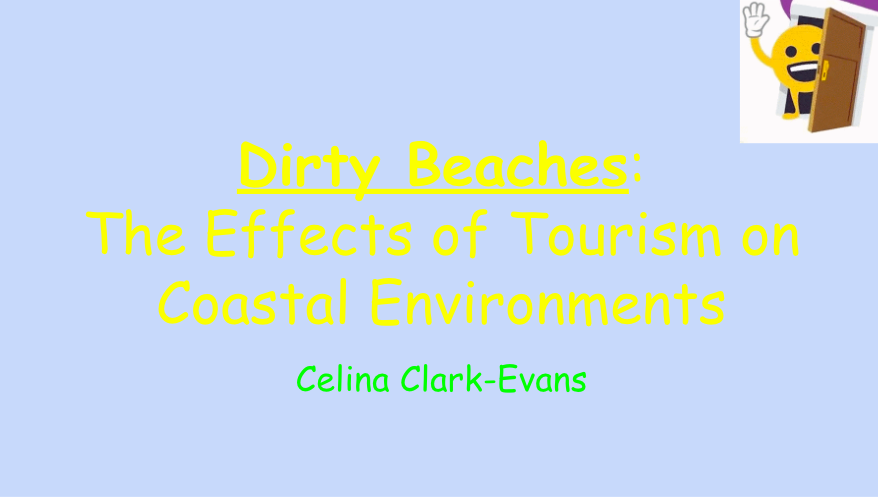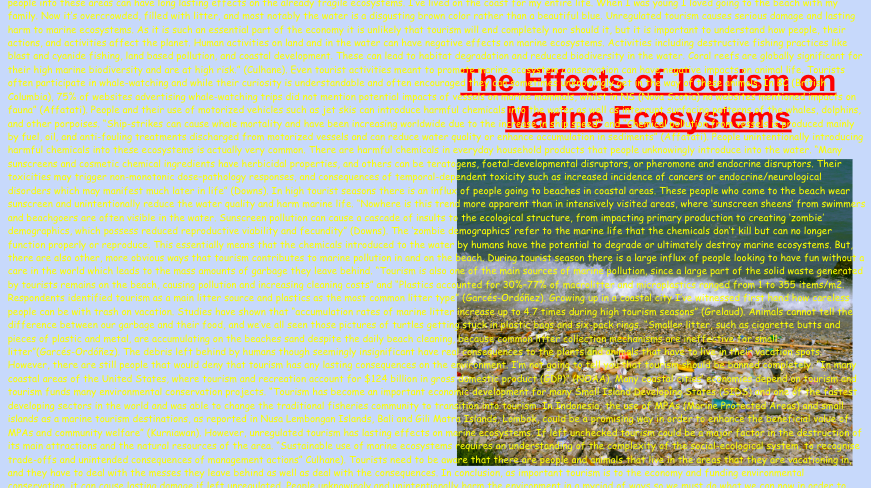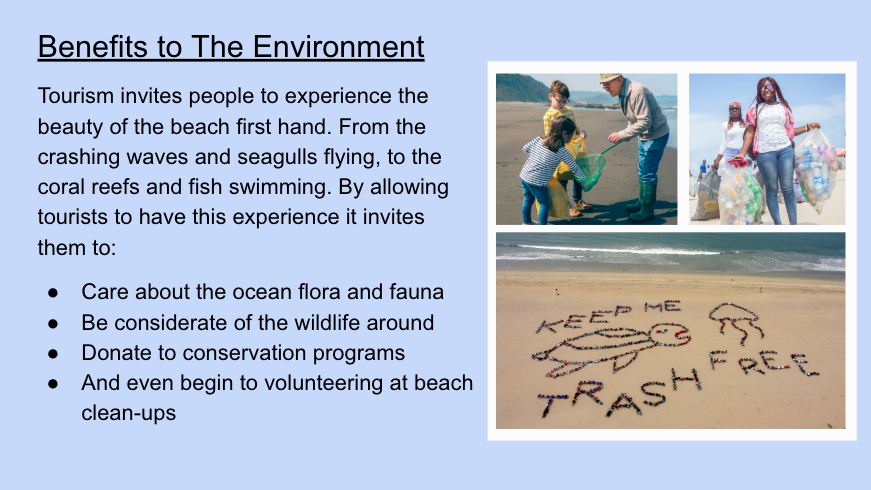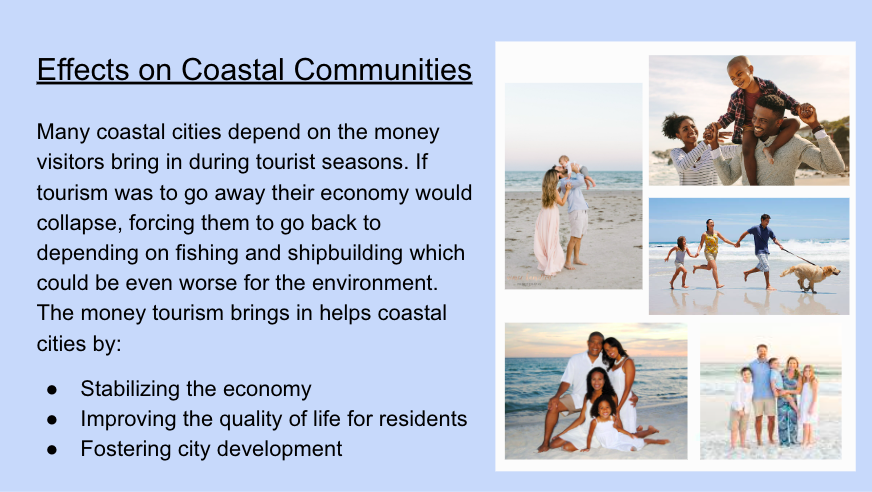Remix:





Genre Analysis
For my genre remix I have turned my research paper on the negative effect of tourism into a powerpoint presentation. This presentation would be used by myself, a marine conservationist, to convince investors to fund projects and legislation that would limit tourism in order to protect the marine ecosystem. The purpose of this presentation would be to inform the investors of the negative impacts of tourism on marine environments while encouraging them to donate to my cause of marine ecosystem preservation. Given the fact that the natural world is deteriorating faster than ever there should be a sense of urgency to salvage and protect what is left of the planet’s natural resources. Of course, because this is not meant to be a convincing presentation I’ll be doing what I can to poorly present the information to deter them from investing.
The first slides of the presentation would be dedicated to introducing the topic and showing the investors the actual information proving that we need proper regulation of tourism, especially in coastal cities. In order to deter people from investing these slides will be presented in the most unconvincing and visually unpleasant way possible. The entire presentation contains light blue slides to replicate the summer sky and ocean blue. These slides however, would have a bright yellow and green text color to make them almost illegible. The title of the slide show would also be “Dirty Beaches” made to sound like the phrase “dirty bitches” which the investors would take as incredibly unprofessional. Given the slides’ unsightliness and unprofessionalism, the potential investors would immediately be put off and apprehensive to what this presentation is about. The second slide while being illegible will be overrun with the information from my research paper. The text will overflow the page and overwhelm the investors viewing it. By overwhelming the investors they will be far too distracted by the absurdity of the presentation to listen to the point about the destructive effects of tourism.
The rest of the presentation would be dedicated to showing the investors the benefits of tourism for the environment, the coastal city inhabitants, and the economy. The investors would ideally be wealthy inhabitants of a coastal city that care about these things. These slides will be presented in a professional manner where the information is legible and to the point the investors will be happy to consume them. Especially after the terrible first slides these ones will be much more pleasant for the viewers to read. The information on these slides is essentially the counter argument from my original research paper. By presenting them in this matter the investors would be discouraged from investing in limiting tourism and possibly even want to spend their money on city development to get more tourists to get more people to come out.
The point of this presentation is to convince potential investors to invest in tourism regulation projects in order to protect the marine environment. By presenting the information that is actually meant to be convincing in the worst manner possible and the counterargument’s information in a visually appealing and professional manner. At best the information in this presentation would deter potential investors from putting money towards tourism regulation projects and at worst actually encourage them to begin funding coastal development to bring in more tourists. If I were an actual marine conservationist presenting this to real investors I would most likely be laughed out of the room and fired from my organization.
Works Cited
Affatati, Alice. “The Role of Operators in Sustainable Whale-Watching Tourism: Proposing a Continuous Training Framework.” PloS One, vol. 19, no. 1, 2024, pp. e0296241–e0296241. PLOS One, https://doi.org/10.1371/journal.pone.0296241.
Culhane, Fiona. “Assessing Impact Risk to Tropical Marine Ecosystems from Human Activities with a Southeast Asian Example.” The Journal of Applied Ecology, vol. 61, no. 12, 2024, pp. 2897–911. British Ecological Society, https://doi.org/10.1111/1365-2664.14812.
Downs, Craig A. “Sunscreen Pollution and Tourism Governance: Science and Innovation Are Necessary for Biodiversity Conservation and Sustainable Tourism.” Aquatic Conservation, vol. 32, no. 5, 2022, pp. 896–906. Wiley Online Library, https://doi.org/10.1002/aqc.3791.
Garcés-Ordóñez, Ostin. “The Impact of Tourism on Marine Litter Pollution on Santa Marta Beaches, Colombian Caribbean.” Marine Pollution Bulletin, vol. 160, 2020, pp. 111558–111558. Elsevier ScienceDirect Journals, https://doi.org/10.1016/j.marpolbul.2020.111558.
Grelaud, Michaël, and Patrizia Ziveri. “The Generation of Marine Litter in Mediterranean Island Beaches as an Effect of Tourism and Its Mitigation.” Scientific Reports, vol. 1, no. 10, 2020, pp. 20326–20326. Scientific Report, https://www.nature.com/articles/s41598-020-77225-5.
Kurniawan, Fery. “Hypothetical Effects Assessment of Tourism on Coastal Water Quality in the Marine Tourism Park of the Gili Matra Islands, Indonesia.” Environment, Development and Sustainability, vol. 25, no. 8, 2023, pp. 7959–85. Springer Nature Link, https://doi.org/10.1007/s10668-022-02382-8.
National Oceanic and Atmospheric Administration. “The Economic Impacts of Marine Debris on Tourism-Dependent Communities.” National Oceanic and Atmospheric Administration, 2025, https://marinedebris.noaa.gov/research/economic-impacts-marine-debris-tourism-dependent-communities. Accessed 11 3 2025.